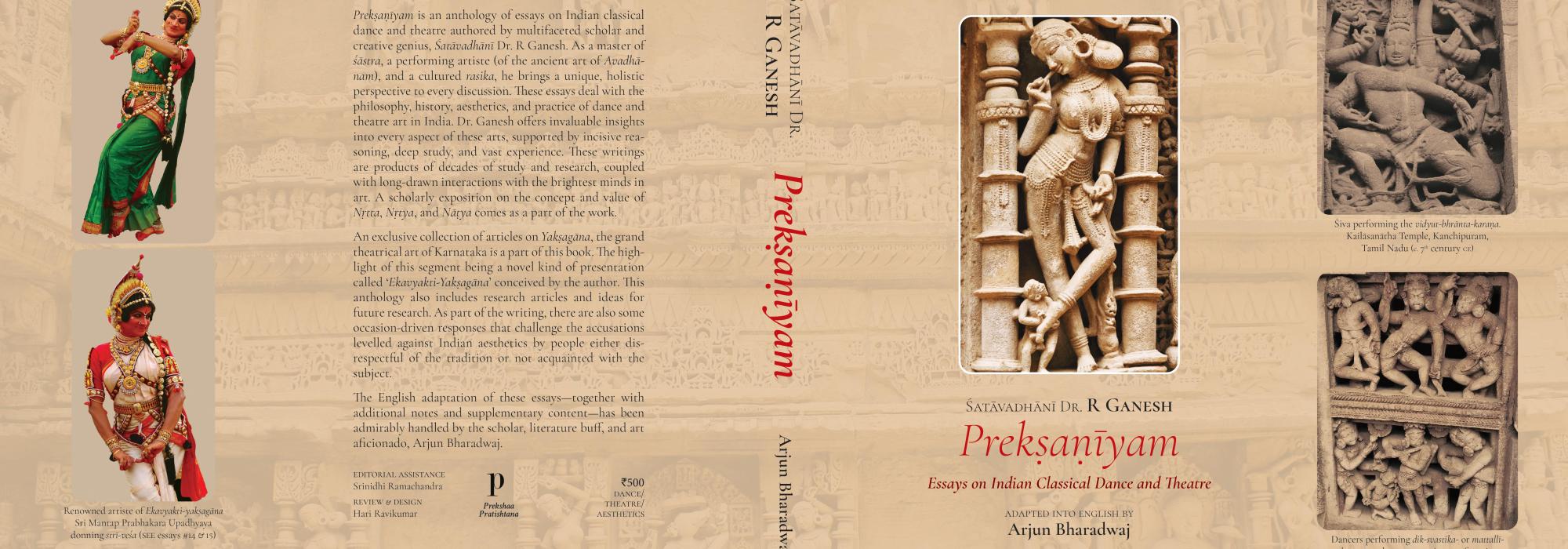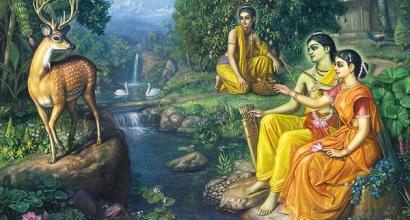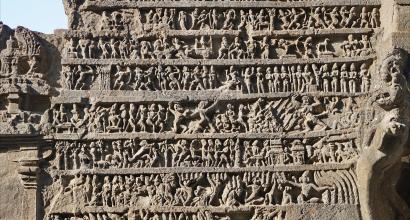Prekṣaṇīyam is authored by Śatāvadhānī Dr. R Ganesh and translated to English with additional material by Arjun Bharadwaj. This is a book on the Essays on Indian Classical Dance and Theatre. It was my fortune that I was invited to speak on the contents of the books on the occasion of the release of its second edition, which was an improvised version of the first edition in terms of inclusion of additional essays, footnotes in more detail and also giving a section for glossary and indices.
Reading this book was a holistic experience to me! As a dancer, it felt time and again (while reading the lines) that, I wanted to say ‘those words’ in ‘that way’ only – they captured my own experiences which I could never have expressed better; this was possible for the author due to the finesse in the intellectualisation of experience (the re-cognition of the cognised). This is truly the extraordinary ability of Dr. Ganesh!
For the same reason, many times I was perplexed how a non-dancer could give such detailing about the experiential aspects of Āṅgika and Sāttvika at the subtlest levels of their communion! I wondered what must have been the author’s skills of observation that enabled him enter into the experiential world of the dancers’ technical journey, besides the journey of emotions of characters. Somewhere I doubted if there really was a difference between the Bhāvayitrī-pratibhā (concious enjoyment of a connoisseur) and Kārayatrī-pratibhā (creative talent of the artiste), as quoted in the śāstras… such seems to be the merging point of the two, despite the fact that the author has not been a dancer himself.
I have penned the above words not as a mere shower of praise for the author, but to acknowledge myself (through this writing) as a keen observer of subtleties in thought and expression wherever they may be found; otherwise of what avail is any learning or performing? How else am I to be convinced that I deserve to write about the contents of this book?
If brilliant expression is the pramāṇa for ‘brilliant thought’ (in terms of performance of nāṭya/ nṛtya), then subtle intellectualisation is the pramāṇa for ‘intense experience’. The latter alone can completely validate the former to the world. That is why we need śāstrīkaraṇa of any alaukika-anveṣaṇa (extraordinary exploration), that enables admissibility to intelligence and endorses the universalisation of artistic experience.. Prekṣaṇīyam is the testimony to this purpose.
I want to share my joy by wading through the pages of Prekṣaṇīyam, quoting here and there those golden words that are revelations of an extraordinary intellect akin to that of the author.
Honestly speaking, it is impossible to capture even the cream of insights covered in this book. It is only my futile effort to even say a few of them which are my favourites. I would only humbly persuade my reader to go through book to really enjoy the horizons envisioned by the author. I humbly confess that I have not attempted to meticulously cover every article too. I have gone by my heart’s call to randomly pick those articles and concepts which have led me into moments of silence that one would experience when extraordinary things are seen or perceived. The reason for such apparent big words about the book is because, while the book is meant to be on technical aspects of dance and theatre, it has emerged out to be an outpour of mahāvākyas of contemplative nature. While there is ruthless indulgence in the discussion on the technique of art, it has not failed to culminate into transcendence of such technique. This apparent contradiction of indulgence versus transcendence in art, has found the conviction of their confluence. What a rarity to behold!
I
One of my favourite articles of the book has been the first one titled, ‘The Need of a Śāstric Framework’.
The author writes, ‘A śāstra is largely a work of scholarship; Pratibhā plays a secondary role in its creation. Pratibhā is independent of external factors, doesn’t have limitations, and is inherent to an individual.’
This is an important difference that is most significant to understand. This lapse in reasoning is the root cause for all confusions and debates about the hierarchy between the two. The author never fails to declare hierarchy whenever it deserves to be mentioned. Without mentioning hierarchy, truth is only half said.
A śāstric approach helps in formalizing and universalizing the experience of pratibhā, which otherwise may be only a game of chance, trusted to be accessed each time, every time! It is in other words, bhakti becoming jn͂āna: an emotional outburst gets formalized when consciously analysed in a śāstra. Pratibhā though innate to self, is otherwise unrevealing. Most creative artistes agree that they cannot explain the creative process. Though this is true, it does not help in completing the experience. The real completion is in the realisation and recognition of a value as a value. Else though it is experienced, it is not completely experienced. Śāstric discipline through the path of pratyabhijn͂ā, helps the artiste realise consciously the value of the experience that was experienced. For this to happen, Pratibhā has to be held on to, even beyond the creative process to pervade the intellect so that the experience is re-processed, and the nature of the experience is enquired critically and interpreted logically. If pratibhā operates beyond the access of reason its concretisation through subtle but incisive logic may be called śāstra. Hence śāstra is external to pratibhā for sure, but very significant for art, artist/artiste and sahṛdaya.
Many definitions and interpretations for the term śāstra have been covered in the article, which is a revelation, as most of the times the performing artistes think that śāstra means bookish knowledge and a mere burden on the brain.
Just for a sample – the author quotes Śaṅkarācārya and says, ‘śāstra is not a kāraka (enforcer/doer) but is a jn͂āpaka (reminder/cue). Just as a person’s portrait helps us in bringing him back to our memory, śāstra works as a memory peg.’
Another very significant point is the difference between paramparā and saṃpradāya. The author says that paramparā is mere continuity while saṃpradāya is something which has come down to us in its holistic essence, distilled across generations. He clarifies that only saṃpradāya can bring in classicality to art.
This article by the author has not spared any minute detailing in the realm of subtilities. The crux is that this article has cleared all doubts with respect to the need of śāstras for practicing artistes by reiterating how much they are indispensable. At the same time, the author gives caution of how śāstra has been misinterpreted and narrowed down to futile memorisation, which does not contribute to holistic development of the artiste. I honestly find this article as a ‘must read’ for artistes. Age old debates are put to rest with unprecedented and impeccable clarity through this writing.
II
The next article, ‘Nāṭya, Nṛtya and Nṛtta: Some Thoughts’ has added many dimensions to understanding the terms nāṭya, nṛtta and nṛtya. There are some extraordinary sentences that have philosophised the technique, purpose, and the nature of enjoyment about them.
Some unmissable ones are,
- Nṛtta is man’s natural and intangible expression of ecstasy and joy.
- Although nṛtta is charming in its form, it does not narrate a story or depict concrete emotions and doesn’t leave a deep impact on its audience. It does not trigger introspection in the audience and cannot result in śānta.
- Nāṭya is an outward expression of man’s maturity. From an evolutionary perspective, nāṭya possibly developed after nṛtta but from a philosophical perspective, nāṭya as a value and realisation is timeless; therefore, it is older and more fundamental than nṛtta.
As an extension to this article some more wonderful thoughts have been penned in the article, ‘The Basis and Value of Nāṭya and Nṛtya’.
The philosophical conclusions that have appeared in this article are unparalleled, despite the fact that every article somewhere ends up giving this feeling!
- ‘India seems to be the only civilization that has philosophically contemplated upon the nature of Ānanda and realised it to be the ultimate outcome of art.’
- In the western world, philosophy of art appears to be amalgamation of different points of view held by aestheticians at different points of time. Aesthetics seem to be subjective to the aesthetician.
The second point has been elaborately dealt with – how philosophy and aesthetics in the West have not had the vision that India has; the Sanātana-dhārmic approach to art, life, and philosophy in India has been its strength. The points stated above have established how the philosophy of art was always intact in India and thus newer techniques took birth, developed, and modified, later got sophisticated and then either dissolved into another form or were forgotten in time. Nevertheless, the spirit of Rasa that was embedded in the technique just got passed on, no matter what form the technique took. What more can mankind ask for! What better way can art get eternalised!
This article has given the most valuable understanding of the supremacy of classical arts by showing how they are unaffected by changes in space and time. These statements clearly distinguish between the nature of classical and non-classical arts.
Here is a glimpse in this quote from the book- ‘Classical art has the strength to convey universal emotions in the most impactful manner, without compromising on the dimensions of adhi-bhūta, adhi-daiva and adhyātma.’
I would honestly make a note that this article, to be appreciated and enjoyed, demands a high level of qualification that is based on sattva. The reader should be highly inquisitive, should be technically sound in śāstras (study of authentic sources) and prayioga (experiential knowledge) and should have the courage to be ruthlessly honest to himself to admit the ultimate statements found in the book. These are not just the author’s statements; these are the statements of anybody who has this realisation; they are universalised statements in the true sense!
There are some ‘gems’ about the dharmī concept too.
Many times when the author seems to say that nāṭya-dharmī is more capable. Sometimes, it appears that he opines to say that loka-dharmī is better. While these so-called apparent differences are so deceiving; the author has only shown how and when loka-dharmī becomes more effective than nāṭya-dharmī or vice versa. He has only addressed their application in propriety with the purpose of fulfilling Rasa.
There is this statement that, ‘Loka-dharmī does not give much scope for vakratā-oblique expression. Vakratā stands out as an essential feature of nāṭya-dharmī.’ The above quote is not meant to be derogatory about loka-dharmī, but a caution for its appropriate operative possibilities.
In another place the author writes, ‘all sthāyi-bhāvas and san͂cārii-bhāvas have the greatest appeal when portrayed with large amounts of loka-dharmī that is rooted in the sāttvika-bhāvas. Nāṭya-dharmī comes into action when the sthāyi-bhāvas, san͂cāri-bhāvas, uddīpana-vibhāvas, and other material aspects need to be symbolically represented in classical art. It also plays an important role in providing stylistic finesse for the expression of loka-dharmī.’
The above quote has summarised the purpose and possibilities of nāṭya-dharmī and loka-dharmī in essence. This paragraph indeed needs vyākhyāna through practical performance alone. After all, nāṭya is a performing art. As the author himself is an avadhānī, a poet par excellence and has interacted and observed thoroughly the doyens of nāṭya and nṛtya forms, he has been able to see and pen down the most subtle aspects of techniques. A performer who has not been introspective will not be able to say these statements of the author, despite having experienced them. A mere scholar has no entry into these realms of experiential theorisation. This is the true way of śāstrīkaraṇa and the purpose of all śāstra! The artistes may refer to these theories and check the nature of their experience, which will talk volumes about their sādhana, pratibhā and anubhava. For this one article, the artistes should be eternally indebted to Śatāvadhānī Dr. R. Ganesh!
To be continued...












































